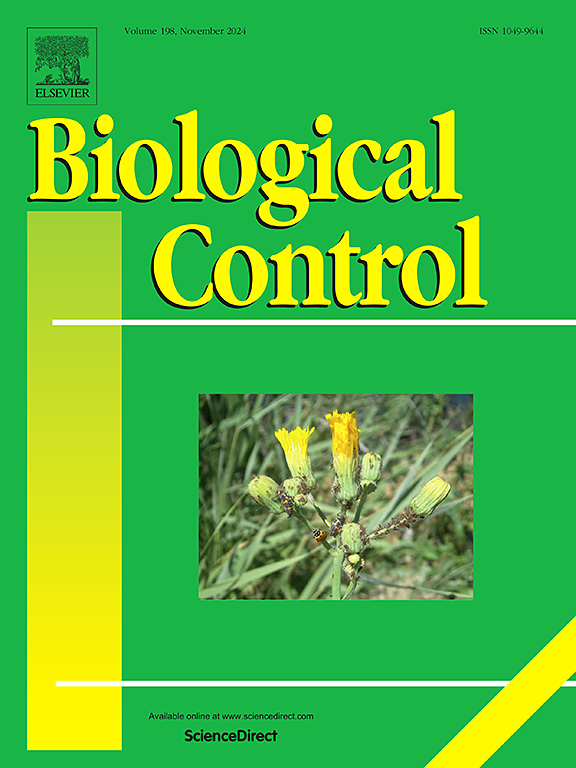基于芽孢杆菌菌株和基础产品的新型和已知生物制品对番茄果实灰霉病的防生活性研究
IF 3.4
2区 农林科学
Q2 BIOTECHNOLOGY & APPLIED MICROBIOLOGY
引用次数: 0
摘要
以天然微生物为基础的生物制品的使用,通过增强果实表面的储存适应性和定殖能力,改善了采前和采后的疾病控制。本研究旨在评价3株番茄分离芽孢杆菌(蜡样芽孢杆菌6C、苏云金芽孢杆菌18D和velezensis芽孢杆菌23A)和3种解淀粉芽孢杆菌亚种的商业化生物制品的有效性。研究了植物D747、盐酸壳聚糖和木耳单独及混合对番茄果实灰霉病的防治作用,探讨了菌株防治番茄果实灰霉病的可能作用机制。所有测试菌株在病原体接种前3天使用时,在伤口和浸渍处理中,将疾病发病率和严重程度降低了60%以上,表现出与商业生物制品相似或更好的性能。即使在病原体挑战前10天施用,B. velezensis 23A也表现出最佳的性能和持久性。对番茄贮藏过程中芽孢杆菌种群动态的监测表明,拮抗菌的存活率较高。芽孢杆菌菌株能够分泌毒性代谢物和负责细胞壁降解的酶。相反,与水杨酸(SA)和茉莉酸(JA)信号通路相关的基因以及与致病相关蛋白(PRs)的生物合成相关的基因在番茄中没有被B. velezensis 23A诱导表达。综上所述,这些结果突出表明,细菌菌株长时间在宿主表面定植并分泌有毒代谢物和酶的能力可能是疾病控制水平所依赖的主要因素。此外,本研究也为今后开发采前应用于碳圈的生物接种剂,实现采后灰霉病的生态管理提供了依据。本文章由计算机程序翻译,如有差异,请以英文原文为准。
Biocontrol activity of novel and known bioproducts based on Bacillus strains and basic products against Botrytis cinerea in tomato fruit
The use of bioproducts based on native microorganisms improves pre- and postharvest disease control by enhancing adaptability during storage and colonizing ability of fruit surface. This study aims to evaluate the effectiveness of three tomato-isolated Bacillus strains (B. cereus 6C, B. thuringiensis 18D and B. velezensis 23A) and of three commercial bioproducts based on B. amyloliquefaciens subsp. plantarum D747, chitosan hydrochloride and Equisetum arvense, alone and in mixture, in controlling B. cinerea on tomato fruit, investigating the possible mechanisms of action involved in the biocontrol activity of bacterial strains. All the tested strains reduced disease incidence and severity by more than 60 % when applied 3 days before pathogen inoculation, in both wound- and dip-treatments, showing performance similar or better than commercial bioproducts. B. velezensis 23A showed the best performance and persistence through time, even when applied 10 days before pathogen challenging. Monitoring of Bacillus population dynamics during tomato storage revealed good survival of the antagonists. Bacillus strains were able to secrete toxic metabolites and enzymes responsible for cell wall degradation. Conversely, the expression of tomato genes involved in salicylic acid (SA) and jasmonic acid (JA) signaling, as well as in pathogenesis related proteins (PRs) biosynthesis, was not induced by B. velezensis 23A. Taken together, the results highlighted that the ability of bacterial strains to colonize the host surface for long periods and to secrete toxic metabolites and enzymes is probably the main factor on which the level of disease control depends. Moreover, this study provides the basis for future developing carposphere-competent bio-inoculants to be used in preharvest for an ecofriendly management of postharvest grey mold.
求助全文
通过发布文献求助,成功后即可免费获取论文全文。
去求助
来源期刊

Biological Control
生物-昆虫学
CiteScore
7.40
自引率
7.10%
发文量
220
审稿时长
63 days
期刊介绍:
Biological control is an environmentally sound and effective means of reducing or mitigating pests and pest effects through the use of natural enemies. The aim of Biological Control is to promote this science and technology through publication of original research articles and reviews of research and theory. The journal devotes a section to reports on biotechnologies dealing with the elucidation and use of genes or gene products for the enhancement of biological control agents.
The journal encompasses biological control of viral, microbial, nematode, insect, mite, weed, and vertebrate pests in agriculture, aquatic, forest, natural resource, stored product, and urban environments. Biological control of arthropod pests of human and domestic animals is also included. Ecological, molecular, and biotechnological approaches to the understanding of biological control are welcome.
 求助内容:
求助内容: 应助结果提醒方式:
应助结果提醒方式:


